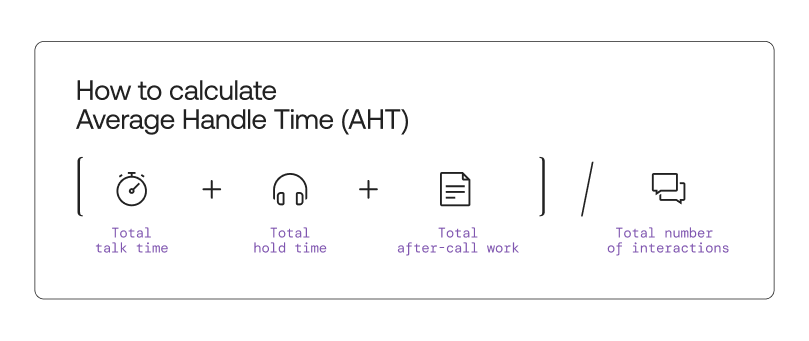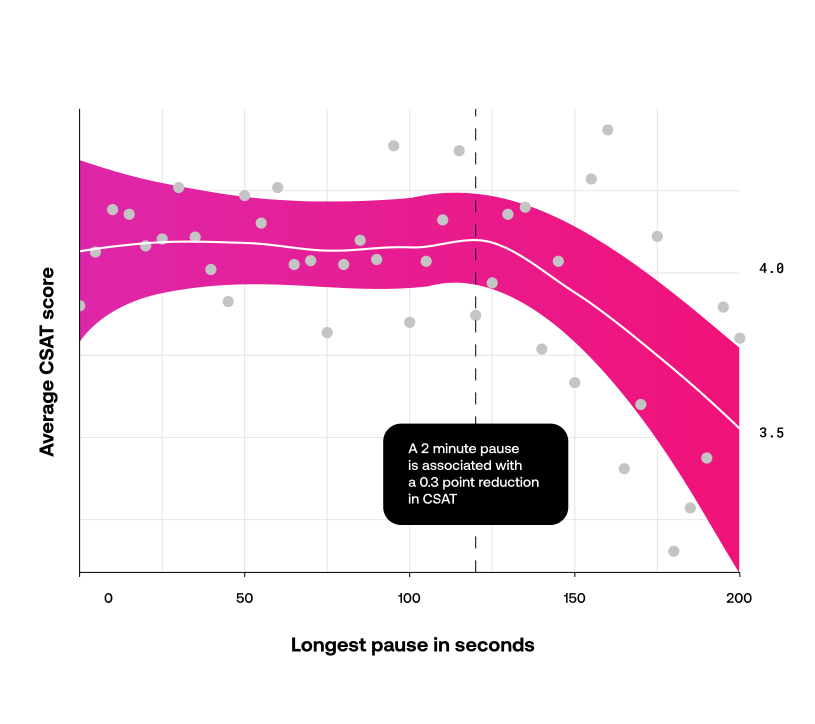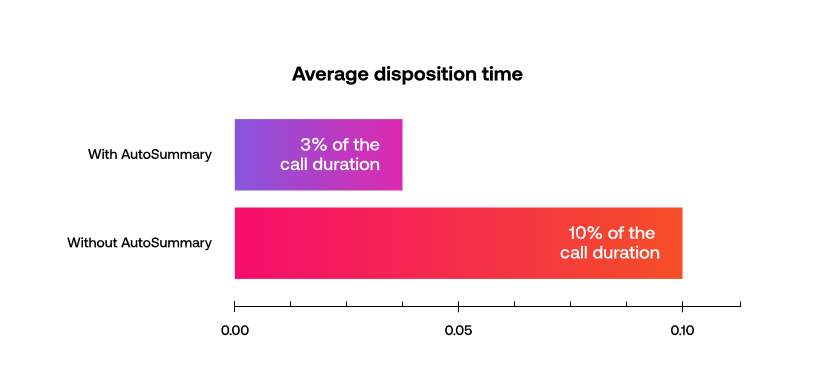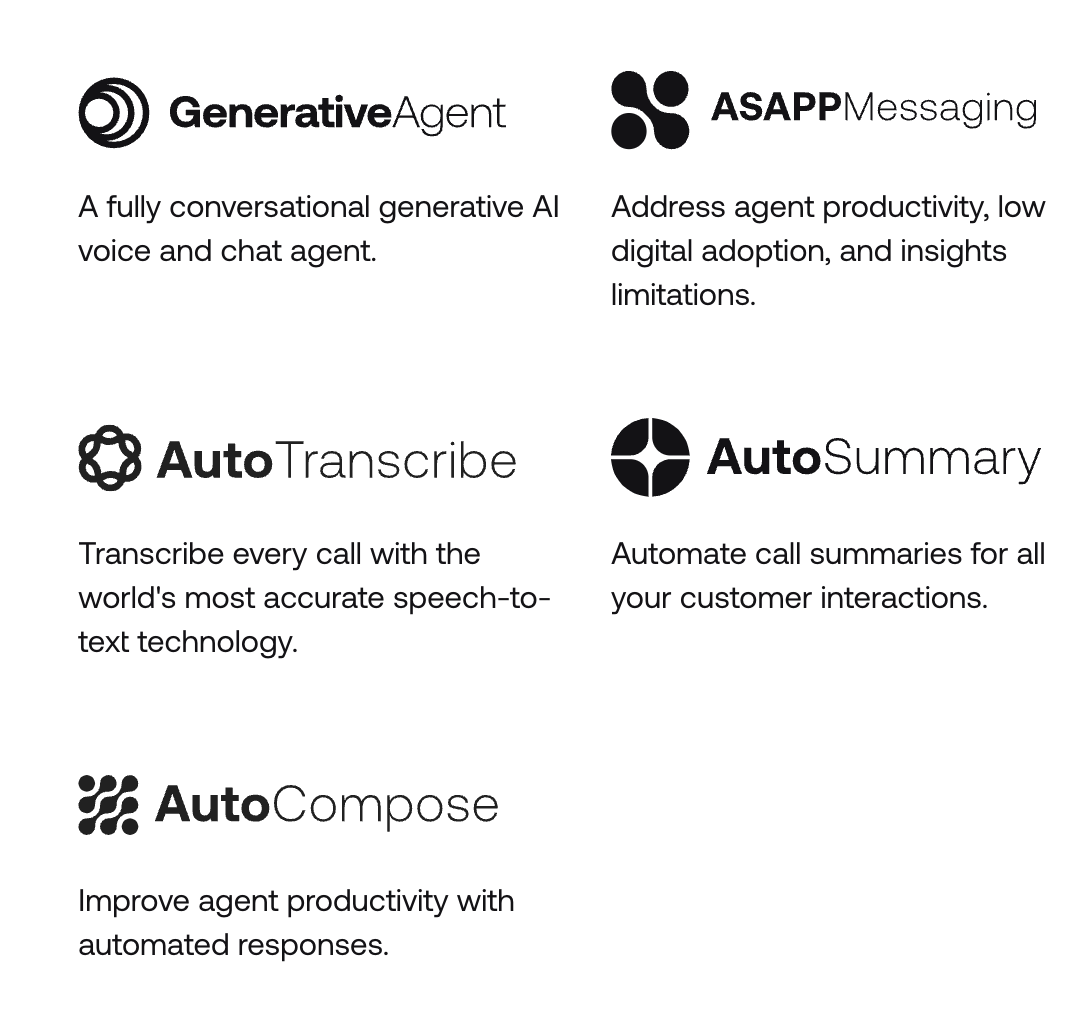AHT Meaning: What is Average Handle Time?
Average Handle Time (AHT) is a key contact center metric. In short, AHT measures the average time of a customer interaction.
AHT provides crucial information about contact center efficiency, staffing needs, and customer experience. And as such, AHT is one of the essential metrics for contact centers to track.
In this blog post, we define AHT and show you how to calculate it. Then, we discuss six impacts reducing AHT can have on your organization. Finally, we provide recommendations for how to reduce AHT while optimizing customer experience.
What is AHT?
Average Handle Time (AHT) is a core call center KPI that measures the average time for an agent to handle a customer interaction from start to finish.
AHT encompasses the entirety of an agent's interaction with a customer issue, including total talk time, hold time, and after-call work (ACW).
How to Calculate AHT
The standard formula to calculate AHT is adding total talk time, hold time, and after-call work and dividing by the total number of interactions.
Talk Time: The time an agent spends actively engaging with a customer
Hold Time: The time an agent spends while a customer is on hold
After-Call Work: The time spent on work that needs to be completed after a call or interaction before the next interaction can start.
In formula form, AHT is calculated as:

Why is AHT Important?
Average Handle Time is one of the most important KPIs for any contact center to track because it impacts both contact center efficiency and customer experience.
Contact Center Efficiency
Average Handle Time distills the time spent across interactions and averages it by the amount of interactions. This one metric impacts the entire contact center organization. Understand AHT and understand how to do the following:
Determine Staffing Loads
Understand how many agents are necessary to handle expected case loads. The lower your AHT, the higher the total number of calls your agents can handle in a given time period.
Benchmark Within the Industry
Compare your AHT to standards across your industry to understand your relative performance.
Benchmark Internal Improvement
Measure your AHT over time to understand if your contact center is more efficiently handling issues, satisfying customers, and effectively utilizing resources.
Understand Individual Performance
AHT can be helpful for analyzing both overall contact center performance and individual performance. While other call center metrics, like customer satisfaction and containment rate are essential to contextualizing the entire picture, AHT can be helpful to understand an agent's capacity and efficiency.
Analyze Gaps
If your AHT is higher than expected, it can be helpful to analyze the individual components of the metric (talk time, hold time, after-call work) to determine where your contact center might need the most improvement.
With this information in hand, you can invest in additional training or update your technology stack with modern software that improves agent efficiency and reduces hold time and after-call work.
Customer Experience
Customers want their issues to be resolved quickly and efficiently. AHT is one of several metrics that helps inform management about how quickly customer issues are being handled. A low AHT implies the following for customers:
Shorter Wait Times
Nobody likes waiting on hold. Reducing AHT by reducing the time customers spend on hold or in a transfer improves customer experience.
Faster Issue Resolution
AHT is a proxy for the time it takes to resolve a given issue. Reducing AHT means customer's issues are being resolved more quickly.
Heightened Customer Satisfaction
Shorter wait times and faster issue resolution contribute to greater customer satisfaction. Work to improve AHT to ensure your customers are having their issues meaningfully resolved quickly.
How to Reduce AHT
Monitor AHT
What you pay attention to grows.
If you want to reduce AHT, the first step is to monitor AHT.
Then, set realistic goals, supported by process and technology changes, to reduce AHT over time.
Modern CX software, like ASAPP, can help you automatically track metrics like AHT over time.
Enhance Self-Service with Modern Virtual Agents
The most efficient way to reduce AHT is to help customers resolve an issue without needing an agent’s support.
But true self-service is more than simply putting a manual’s worth of information online and making it searchable through a help function.
Modern self-service design should leverage modern virtual agents that go beyond simplistic chatbots to handle a broader array of issues, provide more realistic responses, and solve more customer issues before an agent ever needs to get involved.
Augment Agents with the Information They Need
To reduce AHT, contact centers should provide agents with the tools they need to facilitate resolutions quickly and meaningfully.
Digital features that can augment agents include:
- Surfacing Meaningful Information for Agents Automatically
- Automatic Processes Agents Can Leverage to Save Time
- Concurrency Management Tools
- Auto Complete and Auto Suggestion Functions to Help Finish Thoughts Faster
- Automated Workflows to Quicken Common Processes
- Automated Check-Ins to Ensure Clients in the Queue are Still Present
Implement Auto Summaries to Free Up Time
One of the largest contributors to talk time and after-call work is time spent taking notes and writing call summaries.
The time required to take these notes can often be around 10% of the actual call duration and is one of the greatest contributors to high AHT.
With such a large percentage of time consumed by agents taking notes, contact centers are put between a rock and a hard place. If they press agents to reduce their ACW by taking notes during a phone call, it can often lead to prolonged pauses that reduce customer satisfaction. On the other hand, if they ask agents to reduce overall time spent taking notes, it can lead to gaps in summaries that might impact other agents down the road and make it difficult for supervisors to have good visibility.

In short, traditionally, AHT has been difficult to reduce without reducing customer satisfaction. In particular, attempts to reduce ACW by shifting notes into phone calls can either increase talk time or reduce customer satisfaction to an extent that can undermine the initiative altogether.
But now, with modern CX technology, like ASAPP, contact centers can both reduce AHT and increase customer satisfaction.
ASAPP AutoSummary leverages AI to automatically take notes and summarize calls, so agents can focus on the clients. Importantly, ASAPP AutoSummary creates accurate, data-rich, and easily accessible summaries that contact centers and their agents can trust.
With AutoSummary, companies can significantly reduce their AHT and ACW while enhancing the customer experience. In fact, in one case study, ASAPP AutoSummary reduced after-call work from 10% of call duration to just 3% of call duration.

Interested in Learning More About How New Technology is Impacting CX Summaries?
Struggling with agent notes, lengthy after-call work, questionable questionnaires, cumbersome compliance checklists, lack of context for calls, and a lack of definitive understanding of WHY your customers are calling you?
The answer to all of these struggles is the ability to have good summaries at scale.
Unfortunately, you are likely not getting all your business needs from them. Worse yet, they distract your agents from customer conversations and add crucial time to your AHT. This eBook is here to help.
This eBook will cover the best practices and technologies that will deliver the value that good summaries promise without undue agent distraction. Readers will learn:
- What good summaries look like and contain.
- Best practices for summarization - regardless of your methods.
- How new technologies, like generative AI, can both eliminate the need for manual entry and enrich summaries with all necessary vital details.
- What to look for when evaluating summarization technologies.
- How to ensure you are collecting valuable business insights from your summarization efforts.
Download eBook Now
Consider Leveraging Generative Agents
The future is here.
ASAPP GenerativeAgent®, AI-powered chat and voice agents, can empathize with customers, understand complex problems, and access internal APIs and processes to provide helpful answers or initiate actions to solve user problems (with company approval, of course.)
Use GenerativeAgent to resolve issues before an agent needs to become involved. GenerativeAgent can substantially reduce AHT by drastically reducing the time agents spend on interactions and minimizing after-call work. By enabling greater concurrency, Generative Agents increase the number of calls handled in a given period.
Interested in how GenerativeAgent could transform CX? Read more about GenerativeAgent here.
Reducing AHT with ASAPP
Who is ASAPP?
ASAPP is the AI-native software for contact centers, and ASAPP exists to end bad customer service.
We help customer service leaders unlock their full value by minimizing costs & inefficiencies, improving agent compliance & productivity, and surfacing actionable insights while helping you deliver a great customer experience.
Our customers are large enterprises who care deeply about leveraging AI to transform CX by delivering unprecedented cost savings and improving customer satisfaction.
What do we make?
We make a full suite of AI-native solutions designed specifically to help companies reduce AHT and improve customer experience.

Conclusion:
Mastering Average Handle Time (AHT) is essential to operate efficient contact centers and enhance customer experience. By understanding AHT and implementing key strategies to reduce it, contact centers can drive efficiency and delight customers.
Want to learn more?
Transcription and Summarization solutions are not only the foundation of CX intelligence; they are a foundational capability for your AI strategy as well, so you better choose the right ones.
This guide is here to help.
Not all transcription and summarization solutions are built the same. While some may seem “good enough,” those same products can introduce crippling technological debt, may hamper the effectiveness of your other technology solutions, and may fail to surface the discoverable and actionable insights that you were hoping to achieve.
If you are serious about finding the right transcription and/or summarization solution to reduce AHT, this guide will help you understand:
- Exactly what features and capabilities you need in a transcription and summarization solution, and why they are important
- The specific business value the right solution will bring to your organization - from foundational capabilities to reduced AHT and improved customer satisfaction
- A clear and actionable buyer’s checklist to help you with your search
GenerativeAgent can substantially reduce AHT by drastically reducing time agents spend on interactions and minimizing after-call work.







.png)